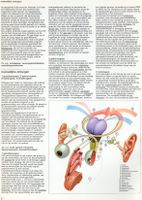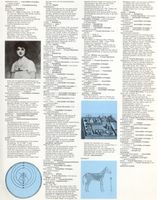Just go back to 1970. Can you imagine that there was no computer in sight in most companies or at home? If they were used in a company they were no more than sublimated calculators. But for an editorial department of a publishing company the IBM golf ball typewriter was the closest to a computer as it had 1Kb of memory. And PCs did not even exist.
In 1970 I took a job as an editor Humanities in a newly created reference department for a general encyclopedia, De Grote Spectrum Encyclopedie. Part of the publishing method was that the editorial staff was going to work with a mini-computer. This calculator would help the editorial staff storing and aligning all the references and links of the 20 volume encyclopedia.


Two pages of a dummy of the Grote Spectrum Encyclopedia (1973; collection Jak Boumans)
Although I did not realise it at that time, working with a computer in a publishing company was not entirely new in the Netherlands. In fact in 1968 Excerpta Medica, a publishing company of magazine with medical scientific abstracts, had bought a mini-computer to do the photo typesetting and all the references. The company had been set up by a group of people among which Pierre Vinken, the later CEO of Reed Elsevier. As a surgeon he came into contact with hospital systems (in the Netherlands with BAZIS) and started to apply the principles for the publishing company. The company started the production unit Infonet for typesetting and text management (these days it would be called content management). Mr Vinken was often consulted by many people and institutes. So he was a consultant to the library world. Yet it would take them till 1979, before the library system PICA, based on the BAZIS system, would be launched.
But online was not visible to me in the early seventies. This, however, changed when I got into a position at a Kluwer subsidiary, where the refernce department was producing three encyclopedias. So phototypesetting was set up and a general mark-up language was used for future derivatives. In fact I remember that in 1978 I attended a meeting of Mr Brian Blunden, president of the British research institute for paper and graphic industry, who toured Europe with the inventor of (S)GML Mr Charles Goldfarb of IBM. It would take till 1990 before Mr Herwijnen in collaboration with Mr Berners-Lee applied the SGML principles to internet and developed HTML.
Besides phototypesetting we developed a lot of new tools, such as alphabet routines, as the American computer alphabet did not suffice. But also on the data entry side, new working methods were developed. With a leased line from the PTT (did we know that this was a monopolist) we linked up a computer terminal with the phototypesetting plant. It was my first introduction to online.
Soon it became clear to me that there was something brewing. The term electronic publishing had been limited to the efficiency of the production process at that time. But towards the end of the seventies new ways of distributing information online came in sight.
Read tomorrow about the first signs of online in the Netherlands.

No comments:
Post a Comment